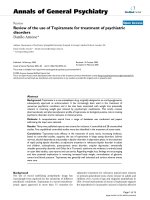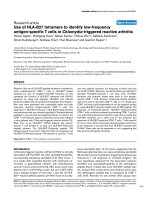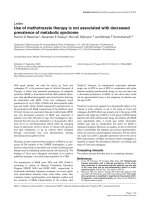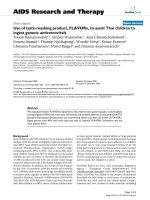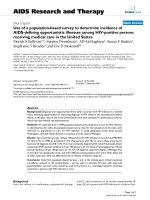Báo cáo y học: "Use of intravitreal bevacizumab in a patient with a Von Hippel-Lindau-associated retinal haemangioblastoma of the optic nerve head: a case report" docx
Bạn đang xem bản rút gọn của tài liệu. Xem và tải ngay bản đầy đủ của tài liệu tại đây (6.09 MB, 4 trang )
BioMed Central
Page 1 of 4
(page number not for citation purposes)
Journal of Medical Case Reports
Open Access
Case report
Use of intravitreal bevacizumab in a patient with a Von
Hippel-Lindau-associated retinal haemangioblastoma of the optic
nerve head: a case report
Timothy A de Klerk and David HW Steel*
Address: Sunderland Eye Infirmary, Queen Alexandra Road, Sunderland, Tyne and Wear SR2 9HP, UK
Email: Timothy A de Klerk - ; David HW Steel* -
* Corresponding author
Abstract
Introduction: The optimum management of a capillary haemangioblastoma affecting the optic
nerve head is not clear. A number of treatment modalities have been used to treat the tumours
and their consequences. Ocular haemangioblastomas express high levels of vascular endothelial
growth factor and levels have been correlated with tumour growth and activity. Treatment with
vascular endothelial growth factor inhibitors would therefore seem a logical approach.
Case presentation: We describe a 23-year-old man with an exophytic capillary
haemangioblastoma of the optic nerve head that was treated with intravitreal bevacizumab
injections.
Conclusion: Unfortunately, treatment with intravitreal bevacizumab on three occasions had no
effect on either tumour size or exudation in this patient.
Introduction
The optimum management of capillary haemangioblast-
oma affecting the optic nerve head is not clear and indeed
it has been described 'as one of the most difficult condi-
tions to manage in ophthalmology' [1]. A number of treat-
ment modalities have been used to treat the tumours and
their consequences including argon laser photocoagula-
tion, transpupillary thermotherapy, radiotherapy and vit-
rectomy surgery [2,3]. The tumours however are
intrinsically related to the neurosensory retina and optic
nerve and treatment often results in adjacent neural dam-
age [2]. Ocular haemangioblastomas express high levels
of vascular endothelial growth factor (VEGF) and levels
have been correlated with tumour growth and activity [4].
Treatment with VEGF inhibitors would therefore seem a
logical approach. A reduction in macular oedema and
exudation has been described following systemic treat-
ment with the intravenously delivered VEGF tyrosine
kinase receptor inhibitor SU5416 [5,6]. We describe a
patient with an exophytic capillary haemangioblastoma
of the optic nerve head that was treated with intravitreal
bevacizumab injections.
Case presentation
A 23-year-old man with Von Hippel-Lindau (VHL) dis-
ease developed a gradually enlarging exophytic haeman-
gioblastoma adjacent to his right optic nerve head (Figure
1). After 5 years of followup he developed a serous detach-
ment of his fovea and argon laser photocoagulation was
carried out with direct treatment of the inferotemporal
portion of the haemangioblastoma using low power
(approximately 120 mW) long duration (0.5 seconds)
Published: 29 May 2008
Journal of Medical Case Reports 2008, 2:182 doi:10.1186/1752-1947-2-182
Received: 13 May 2007
Accepted: 29 May 2008
This article is available from: />© 2008 de Klerk and Steel; licensee BioMed Central Ltd.
This is an Open Access article distributed under the terms of the Creative Commons Attribution License ( />),
which permits unrestricted use, distribution, and reproduction in any medium, provided the original work is properly cited.
Journal of Medical Case Reports 2008, 2:182 />Page 2 of 4
(page number not for citation purposes)
burns. Treatment was carried out on five occasions at 3-
month intervals resulting in a gradual reabsorption of the
fluid but a reduction in visual acuity from 6/12 to 6/24
with a superonasal field defect (Figure 2). The patient was
then observed with no further treatment being required
until 7 years later when he again developed progressive
exudation and serous peripapillary retinal detachment
involving his fovea, reducing his visual acuity to 3/18 (Fig-
ure 3). This coincided with a progressive enlargement of
three cerebellar haemangioblastomas, which were being
observed without treatment. A number of treatment
options were considered for his retinal lesion including
further argon laser and transpupillary thermotherapy.
However, because of previously reduced vision with laser
photocoagulation the patient declined further laser ther-
apy. Treatment with intravitreal bevacizumab was sug-
gested as an alternative possibility. After a full discussion
of this option and observation of gradually increasing
exudation over an 18-month period, the patient had three
intravitreal injections of bevacizumab 1.25 mg in 0.05 ml
given at 1-month intervals. Refracted visual acuity, visual
fields, colour photography, ultrasound and clinical exam-
ination with slit lamp biomicroscopy were carried out
before, 1 and 3 months after the third intravitreal injec-
tion.
There was no improvement in any of the parameters
measured. There was no reduction in tumour size on
ultrasonography or clinically, and no reduction in exu-
dates, macular oedema or area of serous detachment. Vis-
ual acuity continued to decline subjectively but remained
objectively stable with a refracted acuity of 6/36 and n18
for near. Visual fields remained unchanged.
Discussion
Treatment with intravitreal bevacizumab on three occa-
sions had no effect on either tumour size or exudation in
this patient with a capillary haemangioblastoma of the
optic nerve head. Two previously documented cases
treated with the systemic VEGF inhibitor SU5416 have
reported a reduction in macular oedema and an improve-
ment in visual acuity whilst undergoing treatment but a
relapse following treatment withdrawal [5,6]. There was
no change in tumour size despite treatment for 7 months
in one of the cases [5]. There have been two other reports
of intravitreal VEGF inhibitor treatment using pegaptanib
for patients with juxtapapillary or large peripheral hae-
mangioblastomas. In the first [7], two patients with optic
disc haemangioblastomas received six to nine pegaptanib
injections which resulted in an improvement in retinal
exudation and, to a lesser extent, macular oedema but
again no significant reduction in tumour size. Both
patients had had prior vitrectomies, which may have
altered the pharmacokinetics of the drug in the eye. In the
second [8], two of the five patients enrolled in the study
completed the full treatment course of intravitreal
pegaptanib injections which comprised an injection every
6 weeks for a minimum of six injections. Lesions in the
three who did not complete the course continued to
progress, while retinal exudates and central retinal thick-
ness decreased in the other two. Of the latter, one patient
had an improvement in visual acuity of three lines; how-
ever, neither showed a reduction in leakage on fluorescein
angiogram or tumour size.
We chose to use bevacizumab based on its ability to block
all isoforms of VEGF and its availability. The lack of
Fundal Photo – Six years after presentation, post argon laser therapy; note the pigmentation at the site of the laserFigure 2
Fundal Photo – Six years after presentation, post argon laser
therapy; note the pigmentation at the site of the laser.
Fundal Photo – Two years after presentation showing an exophytic haemangioblastoma adjacent to the right optic nerve headFigure 1
Fundal Photo – Two years after presentation showing an
exophytic haemangioblastoma adjacent to the right optic
nerve head.
Journal of Medical Case Reports 2008, 2:182 />Page 3 of 4
(page number not for citation purposes)
response we observed may be due to a number of possi-
bilities.
Firstly, bevacizumab is a large molecule with potentially
less effective retinal penetration than pegaptanib and
therefore less effect on reducing vasopermeability of
affected vessels and the tumour itself. Ranibizumab may
offer superior efficacy, being a smaller molecule with bet-
ter retinal penetration and having a 16-fold higher affinity
for VEGF binding sites than bevacizumab [9]. Secondly,
the intravitreally administered bevacizumab would have
had little or no effect on systemically derived VEGF. The
patient had three separate cerebellar haemangioblasto-
mas, which may have been driving the intraocular process
to some extent.
Thirdly, several hypoxia-induced genes are upregulated in
VHL [4]. VHL is caused by a germline alteration of the
VHL gene, which is a tumour suppressor gene. VHL mRNA
encodes a protein termed pVHL and a lack of pVHL results
in a lack of hypoxia inducible factor degradation, induc-
ing profound intracellular changes that resemble the
changes observed after oxidative stress. This results in
increased levels of several factors including VEGF, erythro-
poietin, platelet-derived growth factor, and transforming
growth factor as well as several other growth factors and
cytokines. It is probably a combination of excessive
amounts of these angiogenic factors that results in the for-
mation of VHL-associated tumours. Blockage of more
than just VEGF may therefore be needed to bring about
tumour shrinkage or even reduced retinal exudation in
some cases.
Finally, it is possible that, because the tumour and exuda-
tion had been present chronically, the three doses of bev-
acizumab used and the period of observation was too
short to allow a clinically apparent improvement to occur.
Further bevacizumab was not given because of the lack of
any clinical benefit. Treatment at an earlier stage may have
been more beneficial.
Conclusion
In summary we observed no therapeutic response to three
intravitreal bevacizumab injections in a patient with VHL
and a peripapillary retinal haemangioblastoma. Treat-
ment with ranibizumab in patients early in the course of
their disease, who have no systemic tumours, could yield
better results. Ultimately however, as Chan et al. have
commented [4], a better therapeutic approach may be to
target the VHL tumour cells directly or indeed the predis-
posing genetic defect.
Abbreviations
VEGF: vascular endothelial growth factor; VHL: Von Hip-
pel-Lindau
Competing interests
The authors declare that they have no competing interests.
Authors' contributions
TAD undertook background research and drafted the
manuscript, DHWS conceived the idea, performed the
procedure and drafted the manuscript. Both authors read
and approved the final manuscript.
Consent
Written informed consent was obtained from the patient
for publication of this case report and accompanying
images. A copy of the written consent is available for
review by the Editor-in-Chief of this journal.
References
1. Shields JA: Discussion. Ophthalmology 2000, 107:54.
2. Garcia-Arumi J, Sararols LH, Cavero L, Escalada F, Corcostegui BF:
Therapeutic options for capillary papillary hemangiomas.
Ophthalmology 2000, 107:48-54.
3. McCabe CM, Flynn HW, Shields CL, Shields JA, Regillo CD, McDon-
ald HR, Berrocal MH, Gass JD, Mieler WF: Juxtapapillary capillary
hemangiomas. Clinical features and visual outcomes. Oph-
thalmology 2000, 107:2240-2248.
4. Chan CC, Collins AB, Chew EY: Molecular pathology of eyes
with von Hippel-Lindau (VHL) disease: a review. Retina 2007,
27:1-7.
5. Aiello LP, George DJ, Cahill MT, Wong JS, Cavallerano J, Hannah AL,
Kaelin WG Jr: Rapid and durable recovery of visual function in
a patient with von Hippel-Lindau syndrome after systemic
therapy with vascular endothelial growth factor receptor
inhibitor su5416. Ophthalmology 2002, 109:1745-1751.
6. Girmens JF, Erginay A, Massin P, Scigalla P, Gaudric A, Richard S:
Treatment of von Hippel-Lindau retinal hemangioblastoma
by the vascular endothelial growth factor receptor inhibitor
SU5416 is more effective for associated macular edema than
for hemangioblastomas. Am J Ophthalmol 2003, 136:194-196.
Fundal Photo – Thirteen years after presentation showing increasing exudationFigure 3
Fundal Photo – Thirteen years after presentation showing
increasing exudation.
Publish with BioMed Central and every
scientist can read your work free of charge
"BioMed Central will be the most significant development for
disseminating the results of biomedical research in our lifetime."
Sir Paul Nurse, Cancer Research UK
Your research papers will be:
available free of charge to the entire biomedical community
peer reviewed and published immediately upon acceptance
cited in PubMed and archived on PubMed Central
yours — you keep the copyright
Submit your manuscript here:
/>BioMedcentral
Journal of Medical Case Reports 2008, 2:182 />Page 4 of 4
(page number not for citation purposes)
7. Chew EY: Ocular Manifestations of Von Hippel-Lindau dis-
ease: Clinical and genetic investigations. Trans Am Ophthalmol
Soc 2005, 103:495-511.
8. Dahr SS, Cusick M, Rodriguez-Coleman H, Srivastava SK, Thompson
DJ, Linehan WM, Ferris FL, Chew EY: Intravitreal anti-vascular
endothelial growth factor therapy with pegaptanib for
advanced von Hippel-Lindau disease of the retina. Retina
2007, 27:150-158.
9. Chen Y, Wiesmann C, Fuh G, Li B, Christinger HW, McKay P, de Vos
AM, Lowman HB: Selection and analysis of an optmised anti-
VEGF antibody: crystal structure of an affinity matured Fab
in complex with antigen. J Mol Biol 1999, 293:865-881.



